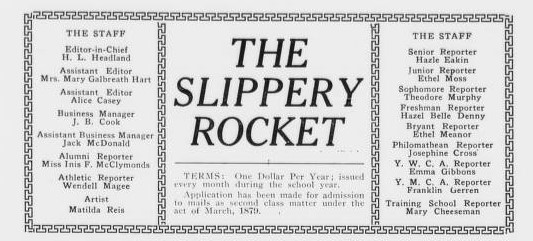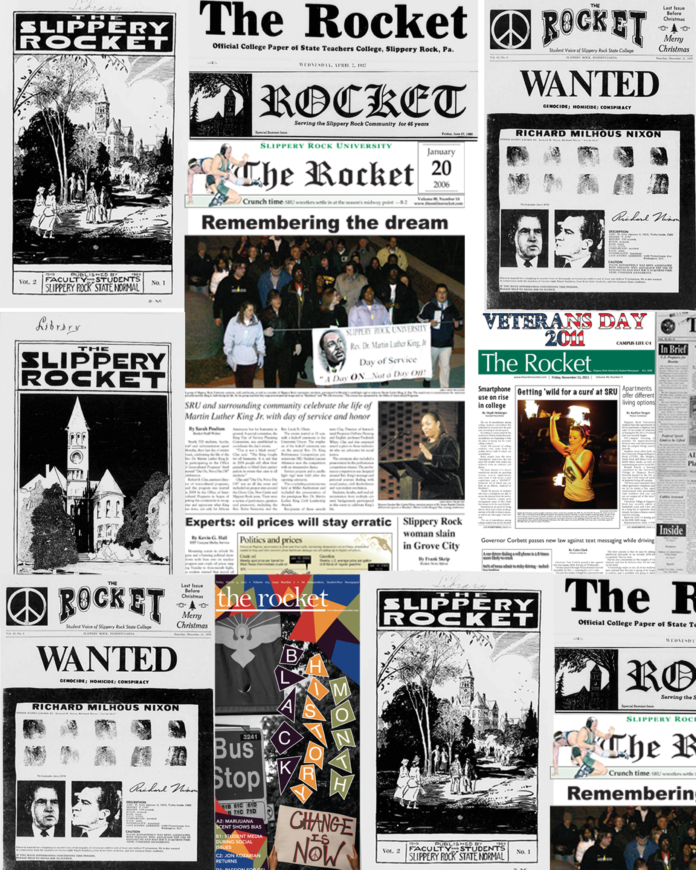More than 104 years after the first edition of the Slippery Rocket, The Rocket is still standing strong with 14 staff members and a female editor-in-chief. From the first edition of The Slippery Rocket in 1918 to the 9-30-2022 edition of The Rocket, SRU’s independent, student-run publication continues to evolve with journalism trends. Sometime soon, newspapers may be nothing but a hologram, and The Rocket will still be going strong.
The archiving process
Fine and Performing Arts Librarian and University Archivist Judy Loney Silva explained that the earliest editions of the Slippery Rocket and The Rocket were microfilmed for the archives and that the physical copies were not saved.
“[Microfilming is when people] take a picture, and they shrink it down teeny tiny, and then they put it under a reel,” she said.
The reels will be viewable for as long as there is the correct technology available to look at them. The Slippery Rocket, The Rocket and the Saxigena—SRU’s Yearbook that ended in 2005—are available on the SRU website under University Archives.
The Slippery Rocket
The first ever Slippery Rocket print edition was published in November 1918. According to the Slippery Rock University Archives, the Slippery Rocket was “published by the faculty and students of Slippery Rock State Normal School.”
The early versions of Slippery Rocket contained a list of 16 staff members, including the editor-in-chief, two assistant editors, business manager, assistant business manager, alumni reporter, athletic reporter, artist, senior reporter, junior reporter, freshman reporter, bryant reporter, philomathean reporter, two Y.W.C.A. reporters and training school reporter.

Within the terms of the edition, it explains that to receive all monthly editions during the school year, readers only have to pay $1.
The first few editions of Slippery Rocket were uniquely structured like books, often with only two columns per page.
The Slippery Rocket published some news items but mostly featured campus events, opinions, and gossip about the people who went to the university at the time.
The last recorded edition of The Slippery Rocket was published on May 21, 1930. By this time, the newspaper was labeled “the official journal of Slippery Rock State Teachers College.” Only a few features had changed since 1918, though, one being the subscription rate, which was now $2 per year and $1 per semester.
The staff positions were also altered. By the last edition of The Slippery Rocket, the positions were the editor-in-chief, business manager, two assistant editors, five reportorial staff, four members of the circulation department, advertising manager and two typists.
One of the more noticeable changes was the structure of the newspaper. It now resembled what people generally think a newspaper looks like, with many columns. The last edition included five columns on each page.
Out with the old, in with the new
There was a brief publication break between 1930 (the last recorded edition of The Slippery Rocket) and 1934, the beginning of the new student-created publication, The Rocket.
There is not much information that could be found as to why the Slippery Rocket ceased production, but Silva theorized that the publication may have been unable to afford the paper due to the Great Depression.
The first edition of The Rocket, published in October 1934, was labeled “the official college paper of State Teacher’s College, Slippery Rock, PA.” The paper at the time was structured similarly to how The Rocket is currently structured, with a headline that read “Rockets Open Home Season Here On Saturday.”
The paper has a calendar of events, a sports section, a news section and a feature about different clubs and events on campus. At the bottom of the first page, there is a message about the introduction of The Rocket that reads:
“College papers have been born more than once in Slippery Rock and have died from one cause or another without attaining a ripe old age. THE ROCKET might he called a grandchild of the one-time SLIPPERY ROCKET. Though it starts out stumblingly on untried feet, we hope it may grow stronger than its predecessors and reach out into greater achievements. THE ROCKET Will endeavor to make our school spirit more uniform, to develop student opinion and offer opportunity for the expression of that opinion, and to acquaint friends of the school with our activities and progress. In order to achieve these aims, THE ROCKET must have the support and encouragement every person interested in our college.”
At this point in publication, new editions of The Rocket were being printed every week.
Funding and defunding
One especially interesting edition of The Rocket is from Dec. 12, 1970. The cover features the word “WANTED” with several pictures of former U.S. President Richard Nixon arranged to resemble mugshots.

A continued opinion piece on the inside highlights the huge anti-war sentiment that many college-aged individuals harbored regarding the Vietnam War.
While not appropriate to publish now, the article was accompanied by a photo of a soldier’s decapitated head with the caption, “It seems somehow blasphemous to ask whose side the former owner of this head was on.”
This edition allegedly caused a change in funding and placement for The Rocket because of its controversy. Previous Rocket Adviser Mark Zeltner said advisors were switching around a lot back in those days.
“I know it bounced around to a variety of advisors back in those days, and it was mostly out of the English department, but then it seemed like there were people in the student services that were advising it,” Zeltner said. “It seemed like it was going through a lot of changes in the 70s.”
The Zeltner era
Since its start, The Rocket has followed the same publication processes as any other newspaper. But just like any other publication, printing techniques have drastically changed. When Zeltner arrived in 1998, The Rocket was in a transitional phase.
“When I got to Slippery Rock in 1998, they hired me and they were still doing it the old way where they had layout tables in The Rocket office,” Zeltner said, “and they would physically print out the pages on the printer and they would paste them down with wax, and they would use line tape.”
The Rocket newspapers were printed in New Castle at the time.
“They would physically lay the paper out, and put it in an envelope, and then drive it to New Castle at two in the morning,” Zeltner said.
When Zeltner was hired as the advisor, he was told to design a website so that they could keep up with the changing times.
“I designed the first website – The Rocket – and came up with the name theonlinerocket,” he said.
Initially, theonlinerocket.com was just posting all the same articles that were found in the newspaper editions that week. Over time, however, the newspaper began printing editions monthly and moving most of its posts to the website. The Rocket is now online for the majority of its content.
It was around this time in the late 1990s that other newspapers were moving to online platforms, and the Rocket never hesitated to stay in step with the big guns.
“It really mirrored commercial newspapers that have all done the exact same thing,” Zeltner said.
The Rocket’s future
Brittany Fleming is the current advisor of The Rocket and WSRU-TV, SRU’s television station. She is looking at the bright future of The Rocket and the many types of media they can explore.
“My goal for the future of The Rocket is to continue encouraging our converged journalism students and students in our TV and video emphasis to really work together and collaborate, so that they are [teaching each other],” Fleming said.
Fleming is invested in expanding the multimedia capabilities of The Rocket. Multimedia is a term that encompasses any works that merge different types of media, such as an article with a video attached to it.
“I would love to expand the multimedia section, or even add a multimedia staff member to each section of The Rocket,” Fleming said. “So, amping up the amount of multimedia that goes into The Rocket.”
She also wants The Rocket to focus on the town of Slippery Rock just as much as they focus on SRU.
“I want sports to cover high school sports. I want campus life to cover community members. I want news to cover things that are happening [in the town],” she said. “It’s not just students that are picking up this newspaper. There are more community members that are actually picking up the newspaper and reading it.”








